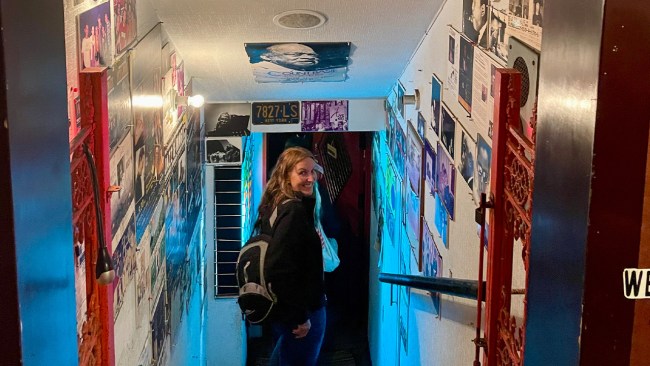This little Japanese island hides a big surprise
Shikoku may be the smallest of Japan’s four main islands, but it’s the ideal place to have an authentic experience in three days.
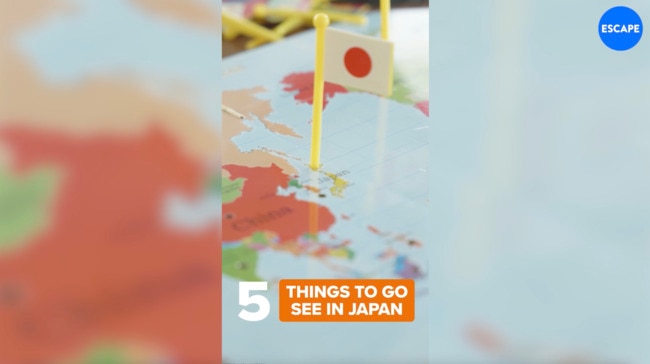
Lifestyle
Don't miss out on the headlines from Lifestyle. Followed categories will be added to My News.
Just a 90-minute flight from Tokyo, Shikoku is the smallest of Japan’s four main islands. Much of its landscape is mountainous, with the population concentrated in urban areas on narrow plains along the coast.
It’s the ideal destination to experience Japanese culture in small cities, while also being able to enjoy stunning landscapes. Over three days we were able to immerse ourselves in the history, culture, nature and, of course, the food this lesser-known gem has to offer.
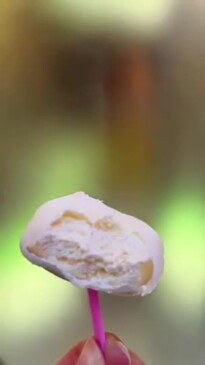
Day 1
Morning
After arriving in Matsuyama, we settle into the Dogo Hakuro, which opened as a “hot spring lifestyle hotel” in 2020. Any lodging with a record player and vinyl records (Toulouse Street by the Doobie Brothers was the vibe) is right by me. Shikoku is famed for its 88 Temple Pilgrimage. The 1200km route can take from 30 to 60 days to complete, though today’s modern pilgrims (or henro) can use cars, bicycles and public transport to augment their journey. Ishiteji Temple (the 51st on the pilgrimage) is as calm and serene as you would expect. Incense is lit, an old man quietly sweeps a stone path and cats laze in the sun. The Yakushi Nyorai, the Buddha at the centre of the temple, is said to cure mental and physical ailments. If you happen to find yourself three-quarters of the way through this pilgrimage, some healing powers could help get you to the finish.
Mid-morning
Next stop is Minakuchi Shuzo, a boutique sake brewery that also makes beer, shochu, gin, limoncello, rum and other drinks. The brewery opened in 1895 and has been run by the Minakuchi family ever since. Our host is the affable Kousuke Minakuchi, who left his job as a Shinkansen systems engineer to return to the family business and become a sixth-generation brewer. He shows us around the traditional home built in 1917 that’s next to the brewery. He also shows us the original plans for the house – beautifully etched into a small square of timber.
Sake is more than just an alcoholic drink in Japan; it’s a vehicle for communion with the gods. Modern Japan is mainly atheistic, but its ancestral religion is Shintoism. Sake has played a part in religious rites and benedictions for centuries. After tasting a few on a steamy morning as crickets and cicadas chorus in the garden, my communion with the gods is fulfilled.
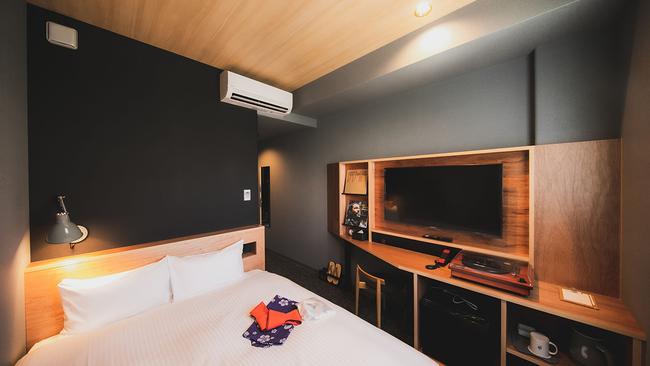
Afternoon
Sitting on a hill high above the city is Matsuyama Castle. Constructed in 1603, the impresssive structure is one of Japan’s few original castles. It is home to an abundance of cultural artefacts and displays such as original samurai suits and historical dioramas (there’s an app you can download that acts as an informative guide). The castle also offers sweeping panoramas of the city across to the Seto Inland Sea. There’s the option of a cable car or chairlift to reach the summit – both sail over Ninomaru Historical Garden. As we leave, a storm is brewing above the mountains to the south. Considering the castle has been damaged twice by lightning, it’s an appropriate cue for us to make our way down to the safety of the plateau below.
Evening
We drive two and a half hours to Kochi, a city with a population of just over 300,000. There’s a Japanese expression that says, “Even sea bream is not delicious when eaten in loneliness.” That doesn’t prove a problem at the bustling Hirome Market, a large food hall packed to capacity with a variety of delicious food options and ice-cold beer. Kochi’s proximity to the sea means fresh seafood is readily available, and I opt for taimeshi (sea bream rice), comprising sea bream and hot rice, topped with raw egg and soy sauce. Mighty tasty! After dinner we venture into the streets to experience the Yosakoi Matsuri festival. Yosakoi is a unique style of dance that is highly energetic, combining traditional Japanese dance movements with modern music. The festival – which hosts around 20,000 dancers– is made up of dance teams in colourful costumes and make-up who flow through the streets all evening. It is a joyous and fun-filled way to end the day.
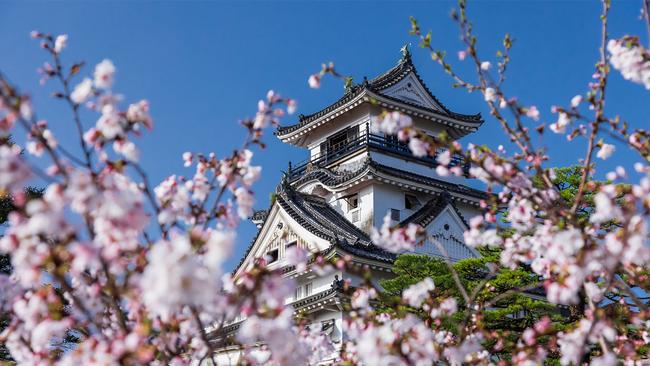
DAY 2
Morning
Another city, another hilltop castle. Kochi Castle was first built between 1601 and 1611, but most of its main buildings date from 1748, when they were reconstructed after a fire. The castle used to be the seat of the Yamauchi lords, who ruled over the surrounding region, then known as Tosa, during the Edo Period (1603-1868). The castle houses local treasures and historical objects and, like Matsuyama Castle, boasts expansive views over the surrounding landscape.
Afternoon
It’s time to leave the cities and venture inland to the Oboke Gorge, gateway to the beautiful Iya Valley. The road runs parallel to the surging Yoshino River, which is swollen after a recent typhoon. Our next stop is the famed Oku-Iya Kazurabashi vine bridges, made of mountain vines (kazurabashi), which provided a vital means of getting people and goods across the river. Two of the surviving bridges still stand side-by-side deep in the inner valley. It can be a hairy experience straddling the 44m flimsy-looking (but now reinforced) Husband Bridge (Otto no Hashi) with the raging waters metres below. People cross gingerly with both hands gripping the structure. We continue towards Hotel Iyaonsen, past dense forests populated with pines, cedar, maple and bamboo. It is midsummer and verdant. The trees must be spectacular in the autumn.
Evening
We settle in for the evening at the remote Hotel Iyaonsen, with gorgeous views down the valley. The views are almost as spectacular as the food, with a menu consisting of local produce that changes seasonally. The black lacquered decor, huge windows and whisper-quiet interior are perfectly matched to our meal that includes grilled ayu trout, pork, grilled shiitake mushrooms with citrus jelly and Iya soba noodles.
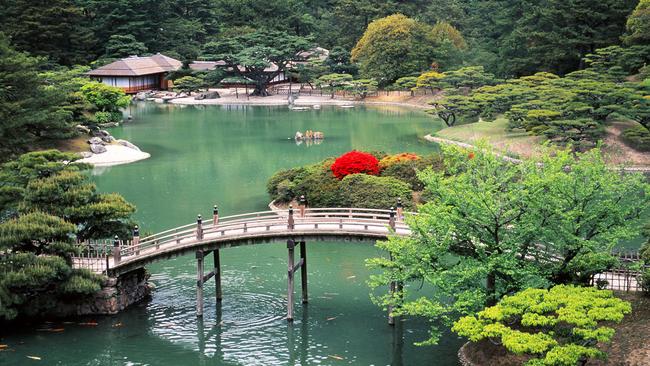
DAY 3
Morning
One can’t stay at an onsen without using the onsen, and the men’s onsen at the Iyaonsen is special. The bathhouse’s fold-out doors are pulled back to reveal a mountain view with a rainbow breaking though the morning mist – appropriate given it’s officially Mountain Day in Japan, a public holiday introduced in 2016 to “honour the mountainous terrain and ecosystems of Japan’s islands and the ancient cultural traditions that are connected with that geography”. Happy Mountain Day, indeed.
Afternoon
It’s a two-hour drive to Takamatsu where we visit the beautiful Ritsurin Garden. Work on the 75ha garden began in the late 16th century and, in 1642, when Yorishige Matsudaira began as ruler of the area, he inherited it. It became a public garden in 1875 and is a wonderful retreat filled with over 1400 pines (many of them pruned to resemble oversized bonsai), ponds and teahouses. The gardens also host swathes of maple trees that turn spectacular autumnal colours in the cooler months. Serene.
The writer was a guest of Japan National Tourism Organization.
Originally published as This little Japanese island hides a big surprise




